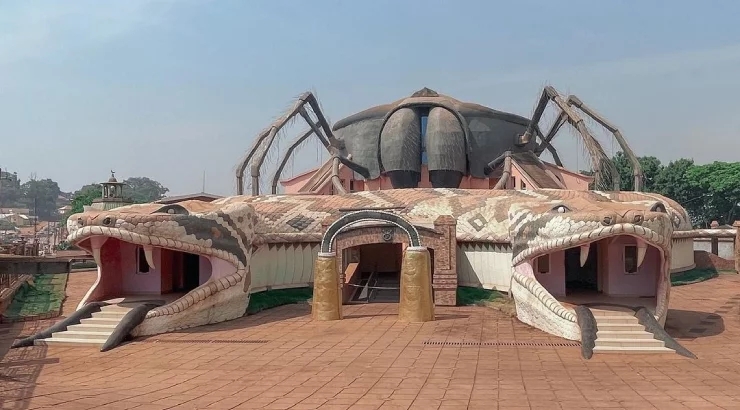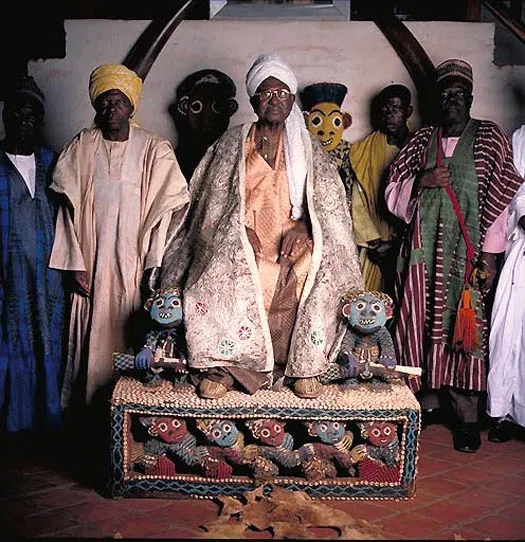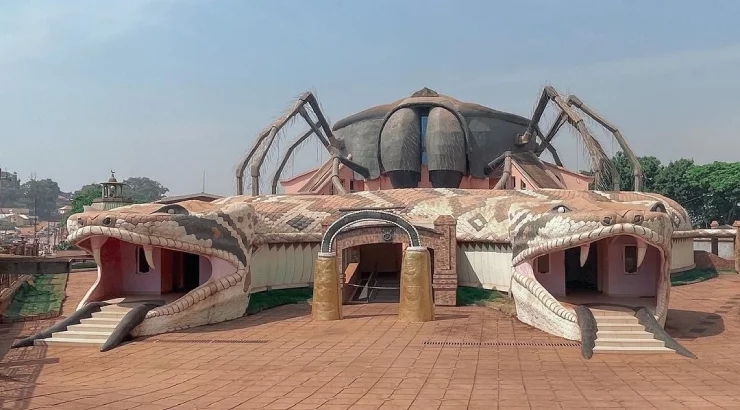To enter the Museum of the Bamoun Kings in western Cameroon, you have to pass under the fangs of a gigantic two-headed snake, the highlight of an imposing coat of arms of one of the oldest kingdoms in sub-Saharan Africa.
Thousands of Cameroonians gathered in the royal palace square in Foumban on April 13th to celebrate the opening of the Museum of the Bamoun Kings. Sultan King Mouhammad Nabil Mforifoum Mbombo Njoya welcomed 2,000 guests to the opening of the museum located in Foumban, the historic capital of the Bamoun Kings.
The royal family, descendants of a monarchy that dates back six centuries, attended the event dressed in traditional ceremonial attire with colourful boubous and matching fezes.
Griot narrators in multicoloured boubous played drums and long traditional flutes while palace riflemen fired shots to punctuate the arrival of distinguished guests which included ministers and diplomats. Then, princes and princesses from the Bamoun chieftaincies performed the ritual Ndjah dance in yellow robes and animal masks.
For Cameroon, such a museum dedicated to the history of a kingdom is “unique in its scope”, Armand Kpoumie Nchare, author of a book about the Bamoun kingdom, told AFP. “This is one of the rare kingdoms to have managed to exist and remain authentic, despite the presence of missionaries, merchants and colonial administrators,” he said. The Bamoun kingdom, founded in 1384, is one of the oldest in sub-Saharan Africa.
To honour the Bamoun, the museum was built in the shape of the kingdom’s coat of arms. A spider, which is over 5,000 square metres (54,000 square feet), sits atop the building while the entrances represent the two-headed serpent. “This is a festival for the Bamoun people. We’ve come from all over to experience this unique moment,” 50-year-old spectator Ben Oumar said. “It’s a proud feeling to attend this event. We’ve been waiting for it for a long time,” civil servant Mahamet Jules Pepore said.

The museum contains 12,500 pieces including weapons, pipes and musical instruments, only a few of which were previously displayed in the royal palace. “It reflects the rich, multi-century creativity of these people, both in terms of craftsmanship and art -Bamoun drawings – as well as the technological innovations of the peasants at various periods: Mills, wine presses etc,” Nchare said.
Also on display are items from the life of the most famous Bamoun King, Ibrahim Njoya, who reigned from 1889 to 1923 and created Bamoune Script, a writing system that contains over 500 syllabic signs. The museum exhibits his manuscripts and a corn-grinding machine he invented.
“We pay tribute to a king who was simultaneously a guardian and a pioneer… a way for us to be proud of our past in order to build the future” and “show that Africa is not an importer of thoughts,” Njoya’s great-grandson, the 30-year-old Sultan King Mouhammad said. To commemorate his grandfather’s work, former Sultan King Ibrahim Mbombo Njoya launched the construction of the museum in 2013 after realising the palace rooms were too cramped.
The opening of the museum comes just months after the Nguon of the Bamoun people, a set of rituals celebrated in a popular annual festival, joined UNESCO’s List of the Intangible Cultural Heritage of Humanity. (© Agence France-Presse 15/4 2024)
In 1914, the Allies invaded the German colony of Kamerun, a region of today’s Cameroon, as part of the West African campaign. Fumban was captured by the British and in 1918, Germany’s colonial possessions, including Kamerun, were divided between Great Britain and France, and the kingdom of Bamoun thus fell under French rule. In 1923 King Ibrahim Njoya was deposed, and his script was banned by the French.

Seidou Njimoluh Njoya ruled the Bamoun people of Cameroon from 1933 to 1992
Other African Monarchies
Monarchy has been the prevalent form of government throughout the history of Africa, where self-governing states, territories, or nations existed in which supreme power resided with an individual who was recognised as the head of state. Many such states exist today. All are similar in that the sovereign inherits their office and typically keeps it until their death or until their abdication.
However, only three are currently sovereign, while the remaining are sub-national monarchies. Two of the former are constitutional monarchies (Lesotho and Morocco), in which the sovereign is bound by laws and customs in the exercise of his or her powers, and one is an absolute monarchy (Eswatini), in which the sovereign rules without bounds.
The sub-national monarchies are not sovereign and exist within larger political associations, such as the Ashanti of Ghana, Bini of Nigeria, and the Xhosa and Zulu of South Africa. Cameroon has more than one hundred such monarchs, including around sixty so called Fons. Since Cameroon’s independence in 1961, the Fons have been under the jurisdiction of the Government of Cameroon. However, they maintain semi-autonomous union councils and jurisdiction over their hereditary land.
Sources and further reading
- The Kings of Africa: 18 Portraits by Daniel Laine – highly recommended, wonderful photographs:
From 1988 to 1991, French photographer Daniel Laine photographed 70 African monarchs, “whose dynasties marked the history of Africa until the middle of the twentieth century.” With hundreds of monarchs to choose from, Laine focused on those who continued to “retain a traditional and spiritual authority that is difficult for the Western mind to comprehend.”
- The 5 Richest Kings In Africa https://www.forbes.com/sites/mfonobongnsehe/2014/06/03/the-5-richest-kings-in-africa/?sh=3722ab3441d2
- Cameroon: How much influence do traditional chiefs really have?
https://www.theafricareport.com/54859/cameroon-how-much-influence-do-traditional-chiefs-really-have
- Historic Museum Bamoun Sultanate Cameroon https://momaa.org/directory/museum-bamoun-sultanate-cameroon/
- Nguon, rituals of governance and associated expressions in the Bamoun community
